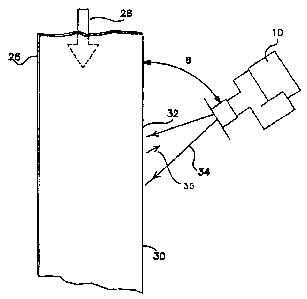Une partie des informations de ce site Web a été fournie par des sources externes. Le gouvernement du Canada n'assume aucune responsabilité concernant la précision, l'actualité ou la fiabilité des informations fournies par les sources externes. Les utilisateurs qui désirent employer cette information devraient consulter directement la source des informations. Le contenu fourni par les sources externes n'est pas assujetti aux exigences sur les langues officielles, la protection des renseignements personnels et l'accessibilité.
L'apparition de différences dans le texte et l'image des Revendications et de l'Abrégé dépend du moment auquel le document est publié. Les textes des Revendications et de l'Abrégé sont affichés :
| (12) Demande de brevet: | (11) CA 2546634 |
|---|---|
| (54) Titre français: | DISPOSITIF ET METHODE PERMETTANT DE MESURER LA VITESSE DE DEPLACEMENT D'UNE BANDE METALLIQUE |
| (54) Titre anglais: | APPARATUS AND METHOD FOR MEASURING STRIP VELOCITY |
| Statut: | Réputée abandonnée et au-delà du délai pour le rétablissement - en attente de la réponse à l’avis de communication rejetée |
| (51) Classification internationale des brevets (CIB): |
|
|---|---|
| (72) Inventeurs : |
|
| (73) Titulaires : |
|
| (71) Demandeurs : |
|
| (74) Agent: | |
| (74) Co-agent: | |
| (45) Délivré: | |
| (22) Date de dépôt: | 2006-05-15 |
| (41) Mise à la disponibilité du public: | 2007-11-15 |
| Licence disponible: | S.O. |
| Cédé au domaine public: | S.O. |
| (25) Langue des documents déposés: | Anglais |
| Traité de coopération en matière de brevets (PCT): | Non |
|---|
| (30) Données de priorité de la demande: | S.O. |
|---|
A meter (10) is provided for measuring a velocity of a metallic strip or band
(30) moving
along a straight path (26). The meter (10) includes an antenna positioned at a
location
along the path (32)) pointing towards the strip edge at an oblique angle, and
a
transceiver electrically connected to the antenna. The transceiver transmits,
in
conjunction with the antenna, a field of electromagnetic energy of known
magnitude and
frequency and receives reflected electromagnetic energy from material (35)
crossing the
field to produce a signal related to the magnitude and the Doppler-shifted
frequency of
the reflected electromagnetic energy. The meter (10) also includes an
amplifier coupled
to the transceiver, a control unit for calibration, and a central processing
unit. The
central processing unit generates an output signal (4-20mA current loop or
voltage
output) based upon data received from the control unit and a signal received
from the
amplifier, proportional to the measured strip velocity.
Note : Les revendications sont présentées dans la langue officielle dans laquelle elles ont été soumises.
Note : Les descriptions sont présentées dans la langue officielle dans laquelle elles ont été soumises.

2024-08-01 : Dans le cadre de la transition vers les Brevets de nouvelle génération (BNG), la base de données sur les brevets canadiens (BDBC) contient désormais un Historique d'événement plus détaillé, qui reproduit le Journal des événements de notre nouvelle solution interne.
Veuillez noter que les événements débutant par « Inactive : » se réfèrent à des événements qui ne sont plus utilisés dans notre nouvelle solution interne.
Pour une meilleure compréhension de l'état de la demande ou brevet qui figure sur cette page, la rubrique Mise en garde , et les descriptions de Brevet , Historique d'événement , Taxes périodiques et Historique des paiements devraient être consultées.
| Description | Date |
|---|---|
| Le délai pour l'annulation est expiré | 2011-05-16 |
| Demande non rétablie avant l'échéance | 2011-05-16 |
| Inactive : Demande ad hoc documentée | 2011-02-17 |
| Réputée abandonnée - omission de répondre à un avis sur les taxes pour le maintien en état | 2010-05-17 |
| Demande publiée (accessible au public) | 2007-11-15 |
| Inactive : Page couverture publiée | 2007-11-14 |
| Inactive : CIB en 1re position | 2006-08-20 |
| Inactive : CIB attribuée | 2006-08-20 |
| Inactive : CIB attribuée | 2006-08-20 |
| Inactive : Lettre officielle | 2006-06-20 |
| Exigences de dépôt - jugé conforme | 2006-06-13 |
| Inactive : Certificat de dépôt - Sans RE (Anglais) | 2006-06-13 |
| Demande reçue - nationale ordinaire | 2006-06-13 |
| Déclaration du statut de petite entité jugée conforme | 2006-05-15 |
| Date d'abandonnement | Raison | Date de rétablissement |
|---|---|---|
| 2010-05-17 |
Le dernier paiement a été reçu le 2009-05-11
Avis : Si le paiement en totalité n'a pas été reçu au plus tard à la date indiquée, une taxe supplémentaire peut être imposée, soit une des taxes suivantes :
Veuillez vous référer à la page web des taxes sur les brevets de l'OPIC pour voir tous les montants actuels des taxes.
| Type de taxes | Anniversaire | Échéance | Date payée |
|---|---|---|---|
| Taxe pour le dépôt - petite | 2006-05-15 | ||
| TM (demande, 2e anniv.) - petite | 02 | 2008-05-15 | 2008-04-28 |
| TM (demande, 3e anniv.) - petite | 03 | 2009-05-15 | 2009-05-11 |
Les titulaires actuels et antérieures au dossier sont affichés en ordre alphabétique.
| Titulaires actuels au dossier |
|---|
| STAN BLESZYNSKI |
| Titulaires antérieures au dossier |
|---|
| S.O. |